Compression treatment for lymphoedema
You can have compression treatment for lymphoedema in different ways, depending on where the swelling is.
What is compression treatment?
Compression treatment aims to control and reduce the swelling caused by a build up of lymph fluid (lymphoedema).
It puts pressure on the area of swelling and encourages movement of lymph fluid around the lymph vessels The pressure needs to be even but firm in the swollen area. Compression may also help to control pain caused by the swelling.
There are different ways to apply compression. They include:
- compression garments
- compression wraps
- compression bandaging
The pressure helps the trapped lymph fluid to move and flow through the lymph vessels. The compression garment, wraps or bandages also act as an extra force for the muscles to work against. This helps the fluid to drain out of the area.
All garments and bandages are measured and fitted by a trained lymphoedema specialist.
Compression garments
Compression garments help to stop lymphoedema getting worse. They can reduce mild to moderate swelling. Your lymphoedema specialist will usually recommend multi-layered bandaging first if you have severe lymphoedema.
The garments vary in how much pressure they put on the tissues. They should:
- cover the whole area of the swelling
- allow you to move normally
- not have any baggy or loose areas
- be comfortable, giving firm support that is not too tight
- be chosen just for you
- be replaced every about every 6 months – they lose shape with washing which affects the amount of compression
You should wear the garments during the day and take them off at night, unless your specialist tells you to keep them on longer. Put them on as soon as possible in the morning. You need to wear them when you’re doing any form of exercise.
Keeping your garments in good condition
You usually have 2 garments so that you can wear one and wash one. Follow the washing instructions using a mild washing powder or liquid. Dry the garment flat, away from direct heat.
At first, your lymphoedema specialist will measure you about every 6 months. This is to check you have the right size garment. You may be measured more or less often depending on your individual needs. You can get a repeat prescription for the garment if your swelling is not changing and your garment fits well.
Contact your doctor, nurse or physiotherapist if you think the garment isn’t right.
Garments for different parts of your body
There are different types of compression garments. The type you need will depend on where your lymphoedema is and how much swelling you have.
You should be able to put the sleeves or stockings on and take them off easily. Here are some tips for putting them on:
-
Make sure your skin is clean and dry, and any moisturiser has been fully absorbed.
-
Wear rubber gloves to make it easier and to stop any snagging.
-
Fold the garment back on itself to the level of the ankle or wrist – make sure all of it is smooth.
-
Pull it onto your limb up to the knee or elbow. Then pull the bit that was folded back up the rest of the limb.
-
Smooth the garment with your gloved hand to make sure there aren’t any wrinkles.
To take the sleeve or stocking off, fold it back on itself to the knee or elbow. Then pull it off the rest of your limb.
Your specialist can provide aids to help you put on your compression garments if you have difficulty.
These photographs show an example of a sleeve and gloves for arm and hand swelling.


An example of stockings for leg swelling.
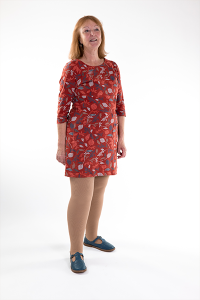
Compression wrap system
Your lymphoedema therapist may suggest a compression wrap system for your swelling. A compression wrap system is a garment that is made up of overlapping, single layers of fabric bands.
You fasten the fabric bands with Velcro fasteners that are easy to attach. You wear a fabric liner that protects your skin underneath the wrap system. The wrap system works in the same way as other compression garments or bandaging but might be easier to put on.
Your lymphoedema specialist will tell you more about these compression wraps if they are suitable for you. They will also provide them or help order them for you.
You can sometimes use a ready-made garment, such as a sports bra or vest. Speak to your lymphoedema specialist first before doing so. Occasionally people need a compression bra or vest that's made to measure.
Bras or tops should not dig into the chest, back or shoulders. Your lymphoedema specialist can tell you what you need to wear. It will depend on where you have swelling.
An example of a compression bras for breast swelling.

You can get compression garments made to measure to help control lymphoedema in the genital area. Cycling shorts or other types of sporting clothes that contain lycra may work just as well.
You need to get your specialist to make sure they fit properly, don’t dig in, and are comfortable.
Men might need to wear a scrotal support. You might also need to wear padding to protect your skin. Your lymphoedema specialist can advise you.
An example of compression shorts for women with genital or tummy (pelvic) swelling:
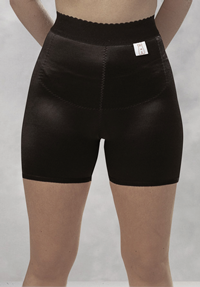
Examples of compression shorts for men with genital or tummy (pelvic) swelling and a Whitaker pouch for scrotal swelling:
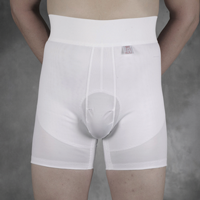
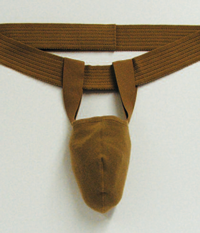
The head and neck area can be a difficult area to apply compression that is also comfortable. But there are compression garments available. They apply light pressure and can be made to measure.
Your lymphoedema specialist will help you get the right garment that is suitable for you. It's important that you only use compression garments provided by your specialist.
You shouldn't wear anything around your neck.
An example of a garment that can help with swelling in the face.
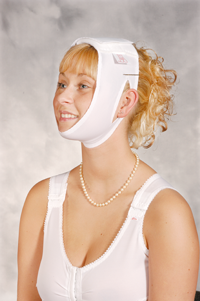
Compression bandaging
Bandaging for lymphoedema is called multi-layered lymphoedema bandaging (MLLB).
The aim is to help lymph fluid to drain and stop it building up. It can also help the swelling get back to near a normal shape as possible.
You usually have daily bandaging during intensive treatment. You have it for a few weeks and might have it with or without a specialised type of skin massage called manual lymphatic drainage (MLD).
Your lymphoedema specialist does your bandaging in a particular way. It is very important to have bandaging done by a trained lymphoedema specialist. It might not work if the bandaging is uneven or not done properly. It could even increase your swelling. Or the swelling may build up unevenly.
How your specialist puts on bandages
How your specialist applies your bandages depends on the type of bandages used. There are various layers:
- finger or toe bandaging if you have lymphoedema of a limb
- a tubular bandage
- a layer of soft synthetic wool or foam
- a dense foam layer
- the bandage layer – these are stretch bandages
- taping to fix everything in place
There’s a new type of bandaging that includes just two layers. The foam layer and elastic compression layer stick together. So you don’t need to have them done separately.
Bathing and showering
You can shower or have a bath at home, but you will need to cover the bandaging to keep it dry. Your specialist can help you work out a way to do this.
When you have the bandages changed your lymphoedema specialist will clean, dry, and moisturise your skin. They will then put the bandages back on.
Things that help during bandaging treatment
- Bandaging can be bulky – wear loose or baggy clothes for comfort.
- Wear comfortable shoes that are not too tight if you have lymphoedema of your leg - a large trainer shoe may be helpful. Ask your specialist about shoes or sandals with Velcro fastenings if you have problems getting shoes to fit.
- Contact your insurance company to check if they'll cover you if you drive. The bandaging could stop you reacting as quickly as you would normally.
- Move around normally – movement and exercise helps the bandaging to move the fluid out of the swollen area.
- Aim to do the exercises given to you by your lymphoedema specialist as often as they recommend.
The bandaging should not be painful, uncomfortable or cause numbness or tingling. If you get any of these feelings, remove the bandaging and contact your lymphoedema specialist straight away.



